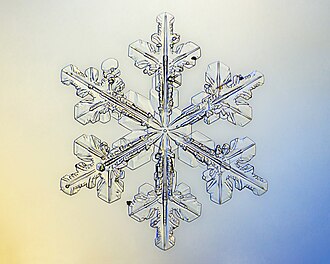
Back ندفة الثلج Arabic Kon ATJ Qar dənəsi AZ Snāgūlė BAT-SMG Floc de neu Catalan کڵۆی بەفر CKB Qar danesi CRH Sněhová vločka Czech Юр пĕрчи CV Pluen eira CY

A snowflake is a single ice crystal that has achieved a sufficient size, and may have amalgamated with others, which falls through the Earth's atmosphere as snow.[1][2][3] Each flake nucleates around a tiny particle in supersaturated air masses by attracting supercooled cloud water droplets, which freeze and accrete in crystal form. Complex shapes emerge as the flake moves through differing temperature and humidity zones in the atmosphere, such that individual snowflakes differ in detail from one another, but may be categorized in eight broad classifications and at least 80 individual variants. The main constituent shapes for ice crystals, from which combinations may occur, are needle, column, plate, and rime. Snow appears white in color despite being made of clear ice. This is due to diffuse reflection of the whole spectrum of light by the small crystal facets of the snowflakes.[4]
- ^ Knight, C.; Knight, N. (1973). Snow crystals. Scientific American, vol. 228, no. 1, pp. 100–107.
- ^ Hobbs, P.V. 1974. Ice Physics. Oxford: Clarendon Press.
- ^ Cite error: The named reference
frisbeeswas invoked but never defined (see the help page). - ^ Lawson, Jennifer E. (2001). "Chapter 5: The Colors of Light". Hands-on Science: Light, Physical Science (matter). Portage & Main Press. p. 39. ISBN 978-1-894110-63-1. Archived from the original on 2014-01-01. Retrieved 2009-06-28.